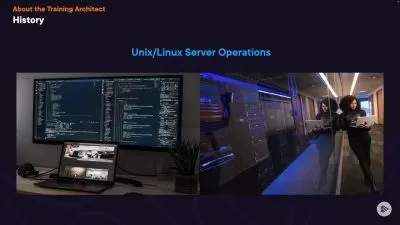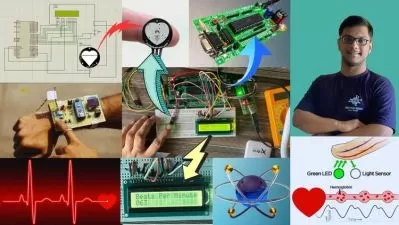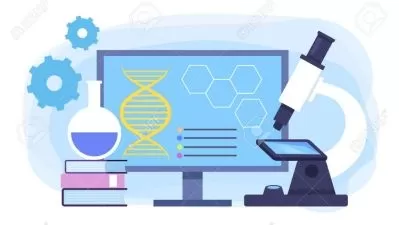Learn ChIP-seq Data Analysis Using bioinfo Linux Pipeline
Abdul Rehman Ikram
2:55:22
Description
Master ChIP-seq Data Analysis: From Quality Control to Peak Annotation and Motif Finding Using Bioinformatics Tools
What You'll Learn?
- Understand the Principles of ChIP-seq: Gain a comprehensive understanding of the principles and applications of ChIP-seq technology in biological research.
- Familiarity with ChIP-seq Workflow: Become proficient in the overall ChIP-seq workflow, from experimental setup to data analysis.
- Install and Configure Bioinformatics Tools: Learn how to install and configure essential bioinformatics tools required for ChIP-seq data analysis, including Fas
- Perform Quality Control: Conduct quality checks on raw sequencing data and remove adapters using Fastp.
- Align Sequencing Reads to Reference Genome: Align sequencing reads to a reference genome using BWA and handle the resulting SAM files.
- Process and Manage BAM Files: Convert SAM files to BAM format, sort, and index BAM files using Samtools, ensuring efficient data management and analysis.
- Filter Reads by Mapping Quality: Filter sequencing reads based on mapping quality to retain high-quality data for downstream analysis.
- Perform Peak Calling: Identify protein-DNA binding sites by performing peak calling using MACS2, and understand the significance of peaks in ChIP-seq data.
- Annotate Peaks: Annotate identified peaks with genomic features using HOMER, gaining insights into the biological relevance of binding sites.
- Discover Motifs: Conduct motif analysis using HOMER to identify DNA sequence motifs enriched at binding sites, enhancing the understanding of regulatory element
- Learn practical and in-demand skills for ChIP-seq data analysis.
- Gain hands-on experience with essential bioinformatics tools.
- Prepare for advanced studies or career opportunities in bioinformatics and computational biology.
Who is this for?
What You Need to Know?
More details
DescriptionUnlock the power of ChIP-seq data analysis with our comprehensive course, Learn ChIP-seq Data Analysis Using Bioinfo Linux Pipeline. Whether you're a beginner or looking to expand your bioinformatics skills, this course provides a step-by-step guide to mastering ChIP-seq analysis using essential bioinformatics tools.
What You'll Learn:
Understand the principles and applications of ChIP-seq technology.
Perform quality control and adapter removal on raw sequencing data.
Align sequencing reads to a reference genome and manage SAM/BAM files.
Filter high-quality reads and conduct peak calling to identify protein-DNA binding sites.
Annotate peaks with genomic features and discover DNA sequence motifs.
Course Modules:
Introduction to ChIP-seq: Learn the basics of ChIP-seq technology and its workflow.
Theoretical Foundations and Tools: Explore the key tools and files used in ChIP-seq analysis.
Linux Essentials for Bioinformatics: Get started with Linux commands and learn to use Linux in Windows.
Practical Pipeline Implementation: Gain hands-on experience with each step of the ChIP-seq data analysis pipeline, from quality control to motif finding.
Intended Learners:
Bioinformatics enthusiasts
Students and researchers in biology, genetics, or bioinformatics
Laboratory technicians and scientists
Data scientists and computational biologists
Bioinformatics instructors and educators
Biotechnology and pharmaceutical industry professionals
Self-learners and career changers
Prerequisites:
No prior bioinformatics experience is required.
Basic understanding of biology is helpful but not mandatory.
Basic computer skills are required.
Join us to gain practical, in-demand skills in ChIP-seq data analysis. By the end of this course, you'll be proficient in using a bioinformatics Linux pipeline to analyze ChIP-seq data, preparing you for advanced studies or career opportunities in bioinformatics and computational biology.
Who this course is for:
- Bioinformatics Enthusiasts: Individuals interested in learning bioinformatics and computational biology techniques, specifically focusing on ChIP-seq data analysis.
- Students and Researchers: Undergraduate and graduate students in biology, genetics, bioinformatics, or related fields who want to gain practical skills in ChIP-seq data analysis.
- Laboratory Technicians and Scientists: Laboratory professionals and researchers working in molecular biology, genetics, or epigenetics who wish to enhance their data analysis skills and learn how to process and analyze ChIP-seq data.
- Data Scientists and Computational Biologists: Professionals in data science and computational biology looking to expand their expertise to include ChIP-seq data analysis using bioinformatics pipelines.
- Bioinformatics Instructors and Educators: Educators and instructors who teach bioinformatics and want to incorporate practical ChIP-seq data analysis techniques into their curriculum.
- Biotechnology and Pharmaceutical Industry Professionals: Individuals working in biotech or pharmaceutical companies who need to analyze ChIP-seq data as part of their job responsibilities.
- Self-Learners and Career Changers: Anyone with a passion for bioinformatics and a desire to transition into a career in bioinformatics or computational biology, even if they are starting from scratch.
Unlock the power of ChIP-seq data analysis with our comprehensive course, Learn ChIP-seq Data Analysis Using Bioinfo Linux Pipeline. Whether you're a beginner or looking to expand your bioinformatics skills, this course provides a step-by-step guide to mastering ChIP-seq analysis using essential bioinformatics tools.
What You'll Learn:
Understand the principles and applications of ChIP-seq technology.
Perform quality control and adapter removal on raw sequencing data.
Align sequencing reads to a reference genome and manage SAM/BAM files.
Filter high-quality reads and conduct peak calling to identify protein-DNA binding sites.
Annotate peaks with genomic features and discover DNA sequence motifs.
Course Modules:
Introduction to ChIP-seq: Learn the basics of ChIP-seq technology and its workflow.
Theoretical Foundations and Tools: Explore the key tools and files used in ChIP-seq analysis.
Linux Essentials for Bioinformatics: Get started with Linux commands and learn to use Linux in Windows.
Practical Pipeline Implementation: Gain hands-on experience with each step of the ChIP-seq data analysis pipeline, from quality control to motif finding.
Intended Learners:
Bioinformatics enthusiasts
Students and researchers in biology, genetics, or bioinformatics
Laboratory technicians and scientists
Data scientists and computational biologists
Bioinformatics instructors and educators
Biotechnology and pharmaceutical industry professionals
Self-learners and career changers
Prerequisites:
No prior bioinformatics experience is required.
Basic understanding of biology is helpful but not mandatory.
Basic computer skills are required.
Join us to gain practical, in-demand skills in ChIP-seq data analysis. By the end of this course, you'll be proficient in using a bioinformatics Linux pipeline to analyze ChIP-seq data, preparing you for advanced studies or career opportunities in bioinformatics and computational biology.
Who this course is for:
- Bioinformatics Enthusiasts: Individuals interested in learning bioinformatics and computational biology techniques, specifically focusing on ChIP-seq data analysis.
- Students and Researchers: Undergraduate and graduate students in biology, genetics, bioinformatics, or related fields who want to gain practical skills in ChIP-seq data analysis.
- Laboratory Technicians and Scientists: Laboratory professionals and researchers working in molecular biology, genetics, or epigenetics who wish to enhance their data analysis skills and learn how to process and analyze ChIP-seq data.
- Data Scientists and Computational Biologists: Professionals in data science and computational biology looking to expand their expertise to include ChIP-seq data analysis using bioinformatics pipelines.
- Bioinformatics Instructors and Educators: Educators and instructors who teach bioinformatics and want to incorporate practical ChIP-seq data analysis techniques into their curriculum.
- Biotechnology and Pharmaceutical Industry Professionals: Individuals working in biotech or pharmaceutical companies who need to analyze ChIP-seq data as part of their job responsibilities.
- Self-Learners and Career Changers: Anyone with a passion for bioinformatics and a desire to transition into a career in bioinformatics or computational biology, even if they are starting from scratch.
User Reviews
Rating
Abdul Rehman Ikram
Instructor's Courses
Udemy
View courses Udemy- language english
- Training sessions 24
- duration 2:55:22
- Release Date 2024/07/24















